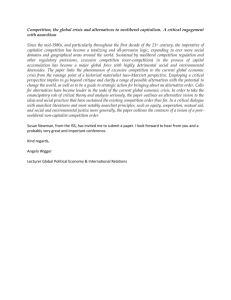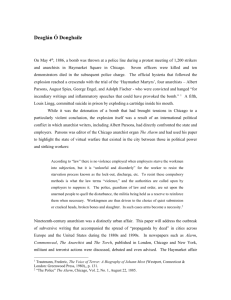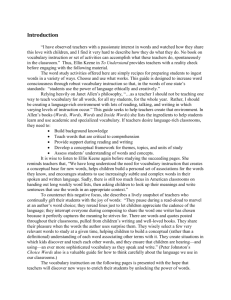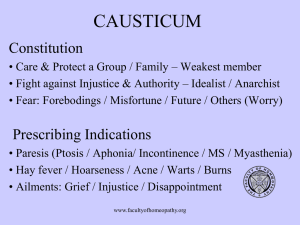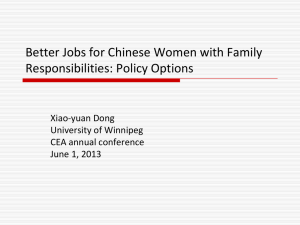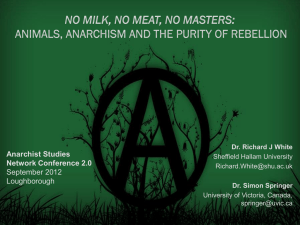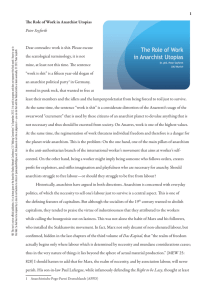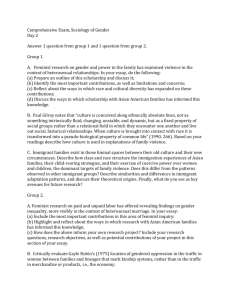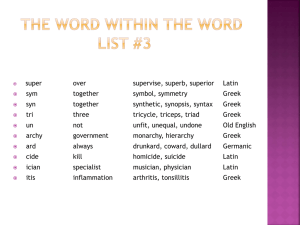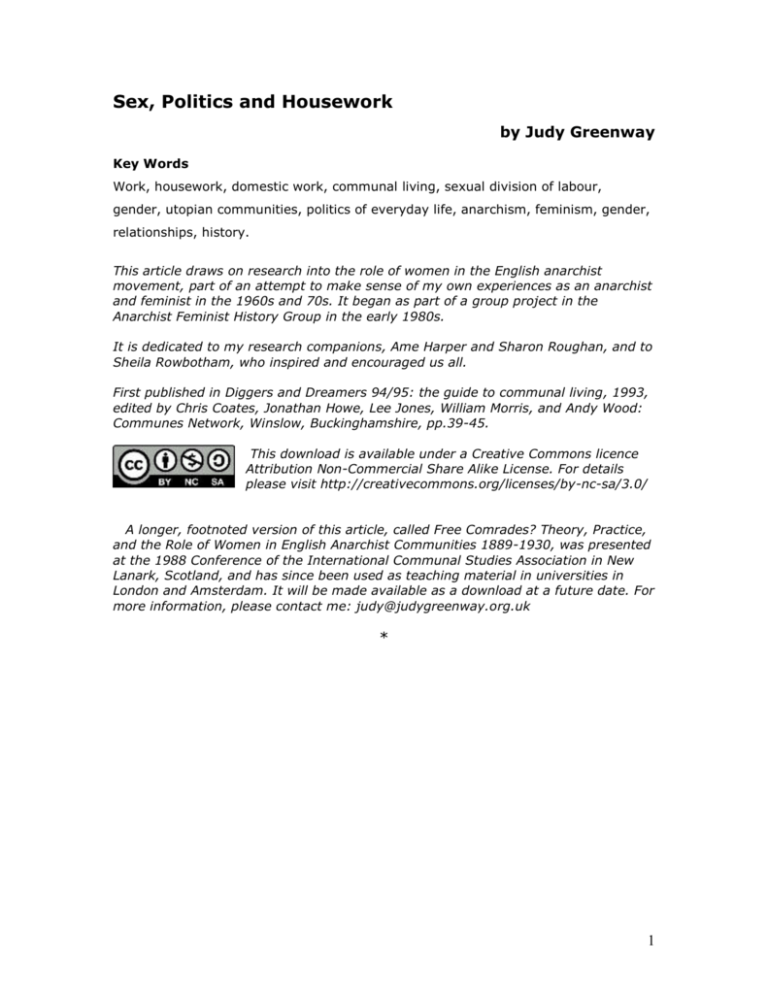
Sex, Politics and Housework
by Judy Greenway
Key Words
Work, housework, domestic work, communal living, sexual division of labour,
gender, utopian communities, politics of everyday life, anarchism, feminism, gender,
relationships, history.
This article draws on research into the role of women in the English anarchist
movement, part of an attempt to make sense of my own experiences as an anarchist
and feminist in the 1960s and 70s. It began as part of a group project in the
Anarchist Feminist History Group in the early 1980s.
It is dedicated to my research companions, Ame Harper and Sharon Roughan, and to
Sheila Rowbotham, who inspired and encouraged us all.
First published in Diggers and Dreamers 94/95: the guide to communal living, 1993,
edited by Chris Coates, Jonathan Howe, Lee Jones, William Morris, and Andy Wood:
Communes Network, Winslow, Buckinghamshire, pp.39-45.
This download is available under a Creative Commons licence
Attribution Non-Commercial Share Alike License. For details
please visit http://creativecommons.org/licenses/by-nc-sa/3.0/
A longer, footnoted version of this article, called Free Comrades? Theory, Practice,
and the Role of Women in English Anarchist Communities 1889-1930, was presented
at the 1988 Conference of the International Communal Studies Association in New
Lanark, Scotland, and has since been used as teaching material in universities in
London and Amsterdam. It will be made available as a download at a future date. For
more information, please contact me: judy@judygreenway.org.uk
*
1
Introduction
By the end of the Nineteenth Century, most English anarchists were
committed to the idea of equality but the trouble was that men's and
women's ideas of what this meant often differed, and even where
there was agreement in principle, the practice was something else.
The numerous anarchist experiments in communitarian living which
flourished from the 1890s onwards brought out some of the difficulties
and contradictions in attempting to change what it meant to be a man
or a woman. Sexual relationships and housework were particular
sources of tension.
Experiments in living
Women often took a leading role in setting up anarchist communities.
What did they hope to gain? In 1912, Lily Gair Wilkinson wrote:
‘I believe that if we begin with immediate personal things,
greater and greater opportunities are likely to occur ... I wish to
express anarchism in my life.’
She saw daily life as one form of political propaganda, and may well
have been thinking of her young anarchist friends living communally in
Marsh House in London.
Two decades earlier, another communal London household, Fellowship
House, promised its inhabitants all the advantages and obligations of a
family without any of its drawbacks, according to member Edith Lees.
She argued that women should reject servitude in the home as she
and her comrades did.
Men also deliberated over the role of women in such communities. In
1894 Henry Binns advertised for other people to help start a fruit-
2
growing co-operative, but he was worried because it ‘… bids fair to
become a Bachelor's Club’, or else a group of married couples and
single men. He wanted:
‘An open, honourable, honest fellowship such as we dream of
and talk of ... but for the most part fail to make for ourselves ...
But, frankly, can we trust ourselves to live above suspicions ...
and jealousies? And, frankly, are our women comrades fitted and
ready for useful work? ... We want women to help us; we cannot
succeed without them; women who want to work for their own
living ... who are as eager to be truer women as we are to be
truer men.’
In 1897, journalist Henry Nevinson recorded in his diary a visit to
Clousden Hill anarchist colony near Newcastle. After naming and
describing some of the men, he wrote:
‘Kapper showed me round ... The leeks, cabbages, rhubarb,
celery, strawberries, roses, pansies were good ... Mushrooms
were supposed to be growing in the glasshouse ... About 100
chickens, 20 ducks, 3 cows, 6 goats. Some rabbits, 2 horses,
and a dog were the livestock: also one woman and three
children.’
This anonymity and relegation of women is a recurrent feature of
many records. To what extent it reflects the status of women rather
than the attitudes of the (male) recorder is difficult to tell. In any case,
women were frequently in a minority in the early days. Single women
joining mixed communities ran the risk of social and familial
disapproval and rejection. Edith Lees believed one reason why so few
women were involved in the Fellowship of the New Life was that
3
women thought that ideals of sex and class equality, moral
regeneration and the simple life were all very well, but impractical.
Housework
Once they had joined a community, women often found housework
was a major problem, Peter Kropotkin, whose writings influenced
many early living experiments, advised the founders of Clousden Hill
to:
‘do all possible for reducing household work to the lowest
minimum ... Arrangements to reduce as much as possible the
incredible amount of work which women uselessly spend in the
rearing up of children, as well as in the household work, are ...
as essential to the success of the community as the proper
arrangement of the fields, the greenhouses, and the agricultural
machinery. Even more’.
The anarchist feminist journal ‘The Freewoman’ carried regular debate
on the housework question in 1911/12. One contributor wrote:
‘As a convinced feminist and aspiring freewoman, I feel that this
question of housework … is absolutely fundamental … Women
have no time to get free. They will only have the time when
domestic work has been properly organised.’
Solutions offered ranged from machine age fantasies to schemes for
collective and cooperative living. The professionalisation of domestic
work was another alternative, though women who already earned their
living as servants weren't convinced that life would be much better
working for a collective household than for individual employers. The
4
simple life held the promise of less housework anyway — but what did
this mean in practice?
The Clousden Hill Prospectus says that all housework is:
‘... to be done on the most improved system, to relieve the
women from the long and tiresome work which unduly falls to
their share today...’
What this meant in real life is not recorded, though in 1897 a visitor
noted that men did the washing, women the cooking and mending.
Whiteway began on communistic lines, and the women did the
domestic work including washing, mending and cooking for all the
men. Eventually the colony moved away from communalism - amongst
other reasons, the women rebelled against doing all the washing when
some of the men wouldn't even collect firewood to heat the water. The
women preferred to do housework for just one man rather than for all
of them.
Other early communities varied in whether men were expected to do
housework. Henry Binns wrote that in his proposed colony, women
would do:
‘Not 'housework' only... but joining us in our work as far as they
will and can, and we so far, joining in theirs’
In Marsh House, before and during World War One, both sexes shared
the housework, but when Tom Keell, the editor of the anarchist paper
Freedom, moved in, he was exempted because his own work was
more important — a recurring theme in male/female relationships.
Even when the women didn't feel that housework was more natural to
5
them, they often ended up doing it on the grounds of efficiency,
because men did it so much more incompetently. Men in men-only
collectives would do their own, though some middle class men felt
humiliated to be seen doing ‘women's and servants' work’ such as
scrubbing steps. In Edward Carpenter's homosexual household at
Millthorpe, though women visitors spoke admiringly of his domestic
skills, they noted that his working class lover took on the major
responsibility for running the house. In mixed communities, working
class women were more likely than the other women to end up doing
most of the work.
Often, women did both ‘women's’ and ‘men's’ work, as at Whiteway
where they were involved in agriculture and building. On their own,
cooperatively, or as part of a family business, some would earn money
by traditional female occupations such as dressmaking, weaving or
craftwork. This was sometimes the major or only source of family
income while the men got on with what was seen as the more
important political work.
Two patterns repeat themselves: one is of women's own political and
economic contribution being undervalued — both by themselves and
historians. (We hear about the men who produced the newspapers —
what about the women who provided the food so they could do it?)
The other is of women who were doing the domestic chores, raising
children, earning money, and also participating in collective work. It is
not surprising that few women had the time to engage in public
political activity after having children.
6
Children
Anarchists had diverse attitudes towards motherhood and childcare.
Most men and many women felt that woman's freedom meant the
freedom to fulfil herself as a mother, with a natural responsibility for
childbearing and often for education as well. They generally believed
that women had the right to bear children outside marriage, and a few
women went further, arguing for women's right to choose to have
children outside an ongoing heterosexual relationship: '
‘As a freewoman, I refuse to bear children either to the state or
to a man; I will bear them for myself and for my purpose ... My
children shall be mine for my pleasure, until such time as they
shall be their own for their own pleasure ...’
On the other hand, one woman wrote:
‘Men must do childrearing if they are to become complete human
beings instead of mere males, if children are to have the benefit
of fathering as well as mothering, and if there is to be real
equality between the sexes.’
This was a rare viewpoint, though, and there is little evidence of men
taking a substantial role caring for young children or of women
suggesting they should do so. ‘Free motherhood’ often proved socially
and materially very difficult for those who tried it, though sometimes
childcare was shared with other women. Older children were seen as
more of a community responsibility, and men sometimes became
involved in education, though less often than women.
Anarchist women were often involved in birth control campaigns, and
some practised birth control or abortion themselves. Certainly, a
7
number of women who were sexually involved with men and wished to
remain politically active chose to have no children, or only one.
Sex
An anarchist manifesto of 1895, in the one line it gave to relations
between the sexes, called for independence and co-operation in sexual
as in industrial and economic relations. Many early communities were
modelled on single sex settlements or religious orders. As the
language of universal brotherhood or fellowship implies, women did
not fit easily into this model, and were often seen as a potential source
of disruption. In some communities, women joined as sexual partners,
not as autonomous individuals. Single women faced particular
problems and pressures both inside and outside the community.
The popular view of the anarchist belief in ‘free love’ was that it meant
constant orgies, and many visiting sightseers must have been
disappointed. Although some anarchist men and a few women believed
in having numbers of partners on the basis of sexual desire alone, for
most free love meant something different: a (heterosexual) freely
chosen monogamous commitment based on romantic love. If love
died, in theory the partnership would end blamelessly. Unfortunately,
love did not always die for both partners at the same time. Women
had more to lose than men in defying sexual convention in a society in
which they were economically and socially unequal as well as being
expected to be responsible for children. They sometimes found that
what they meant and what men meant when they spoke of love or
passion were quite different. Those who didn't believe in monogamy
found sexual jealousy doesn't go away that easily, and in practice the
8
same old double standard of morality, one rule for men and another
for women, often operated.
George Barrett, editor of ‘The Anarchist’, wrote in 1913 that the fight
for the vote was progressive, but the real war for women was in the
home, with men. This was a conclusion many women had already
reached. As one writer to ‘The Freewoman’ acidly pointed out, while
men were theorising, women were actually trying to live out their
theories. They did so with varying degrees of success. Edith Lees said
in later life of her experiences at Fellowship House: ‘Fellowship is Hell;
lack of Fellowship is heaven.’
In urban communities, marriage or its equivalent often meant leaving.
In rural communities, nuclear families tended to develop, leading an
increasingly private existence within the colony. Some women,
disillusioned with the gap between theory and practice, moved away
from anarchist ideas altogether. But for others, however imperfect the
reality compared with the ideals, the struggle for a new life was
preferable to the conventional life they had left behind. They might
leave one colony to found or join another, or to develop similar ideas
in a more individual context. Their daughters and sons would, at least,
struggle for change from a better vantage point.
Bibliography
Guy Aldred, 1958, No Traitor’s Gait, Glasgow: Strickland Press.
Mrs Havelock Ellis, [Edith Lees] 1909, Attainment, London: Alston
Rivers.
Mrs Havelock Ellis, [Edith Lees], 1921, The New Horizon in Love and
Life, London: A&C Black.
9
Dennis Hardy, 1979, Alternative Communities in Nineteenth Century
England, London: Longman.
Edith Lees - see Mrs. Havelock Ellis.
London Anarchist Communist Alliance, 1895, An Anarchist Manifesto,
London: Anarchist Communist Alliance.
Sheila Rowbotham and Jeffrey Weeks, 1977, Socialism and the New
Life: the personal and sexual politics of Edward Carpenter and
Havelock Ellis, London: Pluto Press.
Nellie Shaw, 1935, Whiteway: A colony in the Cotswolds, London:
C.W. Daniel.
Nigel Todd, 1986, Roses and Revolutionists: the story of the Clousden
Hill Free Communist and Co-operative colony, 1894-1902, London:
People’s Publications.
Lilian Wolfe [interview], 1971, Lilian Wolfe – Lifetime Resistance,
Shrew 4:4, London: Women’s Liberation Workshop
Journals
The Anarchist 1912-13.
Freedom 1913
Freewoman 1911-12
Seedtime, 1890-1894
Unpublished sources:
Personal interviews and communications with Tessa Marin, Lilian Wolfe
and Tom Keell Wolfe.
Henry Nevinson Diaries, Bodleian Library, Oxford.
Ramsay Macdonald papers, Public Records Office, Kew.
Labadie Collection, University of Michigan.
10

